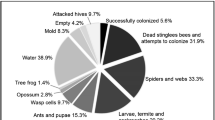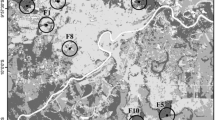Abstract
A field experiment was carried out in two types of forest environment — a relatively homogenous mixed coniferous forest with low plant species diversity and a reach and spatially differentiated alder wood. Spatial variation in activity of voles was sampled by placing ink pads and paper inside PVC waterpipes laid in a line on the forest floor. In the first stage of the experiment, use of space by bank volesClethrionomys glareolus (Schreber, 1780) was analysed without any bait in track collection tubes. In the second stage, we used an attractant in the form of scent collected from alien bank vole individuals of different sex (males, females), age (juveniles, adults) and physiological state (sexually active and not active). In the coniferous forest the distribution of number of visits in tracking tubes was of aggregated character both before and after providing odour of alien individuals. In the alder wood the aggregation level that had been initially lower than in the coniferous forest increased after providing scent. As a consequence, placing scent of alien individuals resulted in decreasing differences in animal distribution in both habitats. The results allow also to the supposition that the reaction to scent depends on sex, age, and the physiological state of the donor.
Similar content being viewed by others
References
Andrzejewski R. and Babińska-Werka J. 1986. Bank vole populations: are their densities really high and individual home range small? Acta Theriologica 31: 409–422.
Andrzejewski R., Babińska-Werka J., Liro A. and Szacki J. 1997. The attractiveness of conspecific and interspecific odor for bank volesClethrionomys glareolus. Acta Theriologica 42: 231–234.
Andrzejewski R., Babińska-Werka J., Liro A., Owadowska E. and Szacki J. 2000. Homing and space activity in bank voles (Clethrionomys glareolus). Acta Theriologica 45: 155–165.
Andrzejewski R. and Olszewski J. L. 1963. Social behaviour and interspecific relations inApodemus flavicollis (Melchior, 1833) andClethrionomys glareolus (Schreber, 1780). Acta Theriologica 7: 155–168.
Andrzejewski R. and Owadowska E. 1994. Use of odor bait to catch bank voles. Acta Theriologica 39: 221–225.
Bondrup-Nielsen S. 1984. The role of habitat heterogeneity and female spacing behaviour in density regulation ofClethrionomys gapperi. PhD thesis, University of Alberta, Edmonton, Canada.
Calhoun J. B. and Casby J. V. 1985. Calculation of home range and density of small mammals. US Publ, Health Monographs 55: 1–24.
Crawley M. C. 1969. Movements and home ranges ofClethrionomys glareolus Schreber andApodemus sylvaticus L. in north-east England. Oikos 20: 310–319.
Drickamer L. C. 1995. Odors in traps: does most recent occupant influence capture rates for house mice? Journal of Chemical Ecology 21: 541–555.
Drickamer L. C., Mikesic D. G. and Shaffer K. S. 1992. Use of odor baits in traps to test reactions to intra- and interspecific chemical cues in house mice living in outdoor enclosures. Journal of Chemical Ecology 18: 2223–2250.
Gurnell J. and Little J. 1992. The influence of trap residual odor on catching woodland rodents. Animal Behaviour 43: 623–632.
Heise S. R. and Rozenfeld F. M. 1999. Reproductin and urine marking in laboratory groups of female common voles (Microtus arvalis). Journal of Chemical Ecology 25: 1671–1685.
Hurst J. L., Robertson D. H., Tolladay U. and Beynon R. J. 1998. Proteins in urine scent marks of male house mice extend the longevity of olfactory signals. Animal Behaviour 55: 1289–1297.
Jamon M. 1994. An analysis of trail-following behaviour in the wood mouse,Apodemus sylvaticus. Animal Behaviour 47: 1127–1134.
Johnson R. P. 1975. Scent marking with urine in two races of the bank vole (Clethrionomys glareolus). Behaviour 55: 81–93.
Johnston R. E., Sorokin E. S. and Ferkin M. H. 1997. Scent counter-marking by male meadow voles: Females prefer the top-scent male. Ethology 103: 443–453.
Kapusta J., Marchlewska-Koj A. and Sales G. D. 1996. Removal of the olfactory system modifies male bank vole behaviour in the presence of females. Behavioural Processes 37: 39–45.
Kozakiewicz M. and Szacki J. 1995. Small mammal movements in a landscape: patch restriction or nomadism. [In: Landscape approaches in mammalian ecology and conservation. W. Z. Lidicker Jr, ed]. University of Minnesota Press, Minneapolis, London: 78–94.
Kruczek M. 1994. Reaction of female bank volesClethrionomys glareolus to male chemosignals. Acta Theriologica 39: 249–255.
Kruczek M. 1997. Male rank and female choice in the bank vole,Clethrionomys glareolus. Behavioural Processes 40: 171–176.
Kruczek M. 1998. Female bank vole (Clethrionomys glareolus) recognition: preference for the stud male. Behavioural Processes 43: 229–237.
Kruczek M. and Marchlewska-Koj A. 1985. Androgen-dependent proteins in the urine of bank voles (Clethrionomys glareolus). Journal of Reproductive Fertility 75: 189–192.
Kruczek M. and Pochroń E. 1997. Chemical signals from conspecific modify the activity of female bank voles (Clethrionomys glareolus). Acta Theriologica 42: 71–78.
Marchlewska-Koj A. 1984. Pheromones and mammalian reproduction. [In: Oxford reviews of reproductive biology. J. R. Clarke, ed]. Oxford University Press, Oxford 6: 266–303.
Mazurkiewicz M. 1969. Elliptical modification of home range pattern. Bulletin of the Polish Academy of Sciences 17: 427–431.
Mironov A. D. and Kozevnikov V. S. 1982. [Movement of bank vole inside and at the edge of the range]. Zoologicheskii Zhurnal 61: 1413–1418. [In Russian]
Olszewski J. L. 1968. Role of uprooted trees in the movements of rodents in forests. Oikos 19: 99–104.
Owadowska E. 1999. The range of olfactory familiarity between individuals in a population of bank voles. Acta Theriologica 44: 133–150.
Rajska-Jurgiel E. 1976. Interactions between individuals of a population of the bank vole,Clethrionomys glareolus (Schreber, 1780). Ekologia Polska 24: 3–35.
Roberts S. C., Gosling L. M., Thornton E. A. and McClung J. 2001. Scent-marking by mice under the risk of predation. Behavioral Ecology 12: 698–705.
Roy V., Belzung C., Delarue C. and Chapillon P. 2001. Environmental enrichment in BALB/c mice — Effects in classical tests of anexiety and exposure to a predatory odor. Physiolology and Behavior 74: 313–320.
Serbenyuk M. A. and Galanina T. M. 1979. [Spatial distribution of chemical signals of bank vole (under experimental conditions)]. [In: 1 Vsesoyuznoe Soveshchenie po khimicheskoi kommunikatsii zhivotnykh]. Izdatelstvo Akademii Nauk SSSR, Moskva: 157–159. [In Russian]
Serbenyuk M. A., Galanina T. M. and Shpilev V. V. 1979. [Influence of chemical signals on the bank vole behaviour in an unfamiliar area]. [In: 1 Vsesoyuznoe Soveshchenie po khimicheskoi kommunikatsii zhivotnykh]. Izdatelstvo Akademii Nauk SSSR, Moskva: 160–161. [In Russian]
Sokolov V. E., Serbenyuk M. A. and Galanina T. M. 1984. O vozmozhnosti opredeleniya ryzhimi polevkami vozrosta sorodichei po zapakhovym signalam ekstsretornykh vydelenii. Izvestiya Akademii Nauk SSSR. Seria Biologicheskich Nauk 2: 223–233. [In Russian with English summary]
van Apeldoorn R., el Daem M., Hawley K., Kozakiewicz M., Merriam G., Nieuwenhuizen W. and Wegner J. 1993. Footprints of small mammals. A field method of sampling data for different species. Mammalia 57: 189–205.
Wallace D. G., Gorny B. and Whishaw I. Q. 2002. Rats can track odors, other rats, and themselves: implications for the study of spatial behavior. Behavioral and Brain Sciences 131(1–2): 185–182.
Ylönen H., Jędrzejewska B., Jędrzejewski W. and Heikkilä J. 1992. Antipredatory behaviour ofClethrionomys voles — ‘David and Goliath” arms race. Annales Zoologici Fennici 29: 207–216.
Author information
Authors and Affiliations
Additional information
Associate Editor was Krzysztof Schmidt
Rights and permissions
About this article
Cite this article
Gortat, T., Kozakiewicz, M., Barkowska, M. et al. The role of chemical information in shaping the spatial activity of bank voles in a free-living population. Acta Theriol 49, 465–477 (2004). https://doi.org/10.1007/BF03192591
Received:
Accepted:
Issue Date:
DOI: https://doi.org/10.1007/BF03192591




